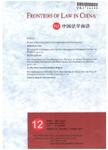TOWARDS A HUMAN DIGNITY BASED APPROACH TO FOOD SECURITY: LESSONS FROM CHINA AND INDIA
TOWARDS A HUMAN DIGNITY BASED APPROACH TO FOOD SECURITY: LESSONS FROM CHINA AND INDIA作者机构:Faculty of LawMcGill University Centre of Human Rights and Legal Pluralism at McGill UniversityMontrealCanada
出 版 物:《Frontiers of Law in China-Selected Publications from Chinese Universities》 (中国高等学校学术文摘·法学(英文版))
年 卷 期:2016年第11卷第2期
页 面:243-265页
学科分类:0301[法学-法学] 03[法学] 1004[医学-公共卫生与预防医学(可授医学、理学学位)] 100403[医学-营养与食品卫生学] 10[医学]
基 金:United Nations UN
主 题:food security human dignity human capabilities right to food
摘 要:Despite almost halving the proportion of the world's undernourished over the past two and half decades, the number of undernourished people in the world remains staggeringly high. Efforts to address the global state of food insecurity must target China and India, which are home to the world's highest and second highest number of undernourished people. This article analyzes the comparative experiences of tackling food security in China and India and adopts an inter-disciplinary approach, which melds legal, economic, and human perspectives to food security. Both China and India have made concerted efforts to improve food security of vulnerable populations in the past three decades. These efforts have historically focused on actively promoting grain production, which has been largely successful in achieving grain self-sufficiency and securing adequate availability of food for their populations. However, the contemporary challenges to food security are now increasingly driven by unsustainable dietary patterns and are exacerbated by growing populations, increasing wealth, and the globalization of food supply chains. As a result, the cause of food insecurity is no longer fundamentally about food supply, but rather about the extent to which marginalized populations are empowered with the rights, freedoms, and capabilities that enable them to attain healthy and productive lives. China and India apply markedly different approaches to address the issue of people's access to food. In India, the right to food movement has gained momentum through the work of civil society actors and there is now a legal right to food. In contrast, in China the right to food is neither stipulated in Chinese law nor referenced to in the official policy rhetoric as the country seeks to ensure access to food by focusing on poverty alleviation more generally through an income transfer program and a non-food based, social safety net to help the poor. At the same time, the Chinese population's high edu



